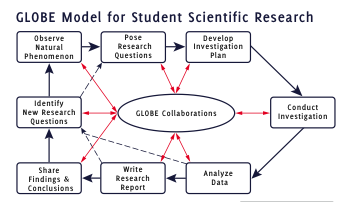Part 4: Albedo Investigation
Guiding Question:
Determined by the student.
Materials (one per group):
- Computer with access to the Internet
- Pencil and Science Notebook
- Albedo Investigation document
- Planning Guide for Scientific Research
Estimated Time:
- 2-3 hrs
What to do and how to do it:
- INTRODUCTION: Briefly discuss how to formulate a research question and a hypothesis, and describe the difference between the two. Discuss the scientific process (i.e. the GLOBE Model for Student Scientific Research in the Planning Guide for Scientific Research) and the importance of flexibility when conducting a scientific investigation (i.e. as you go, you may have to change directions, or re-define your research question based on what tools and resources are available).
- Students spend 5 -10 minutes exploring the Student Climate Data tools and/or Google Maps to identify/ narrow down their research question. Some useful resources include: the Carbon Mapper, the Single Site Albedo Data tool, the Biome resources, and Google Maps. If necessary, the instructor can give a brief tour of the Student Climate Data Tools page to point out the location of useful resources.
- In the Structured experience, students use the Albedo Investigation
handout to record their research question and hypothesis,
and find and record the appropriate data needed to answer
their question in the provided data tables. The Guided
experience provides the opportunity for students to design
their own data tables and/or graphs.
- Instructor supports the more open inquiry process (refining question to conducting investigation) by circulating among groups and encouraging students to pursue researchable questions (e.g., those that can be answered with the available resources and tools).
Assessment
- Use the Checklist for Student Work, or your own rubric, to assess the quality of student work.
- Have students either informally report out to the class on the overall results/trends of their study (orally or using chart paper, the smartboard, etc.) or create a formal report. For suggestions, rubrics, and examples of formal reports, see the GLOBE Carbon Cycle Communicating Findings page.

